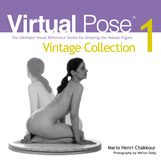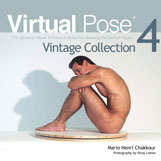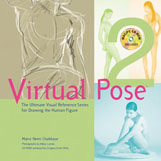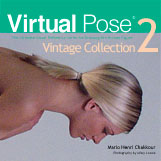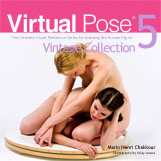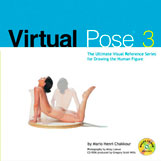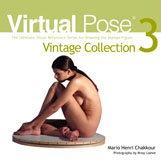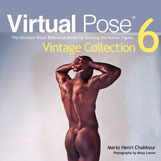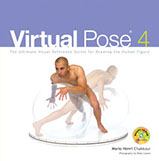Virtual Pose ® 2 VIDEO Tutorials/Transcripts (2001)
By Mario Henri Chakkour, AIA
Copyright © 2001 by StudioView Interactive, LLC. All rights reserved.
Tutorial 1
I would like to start us off with a series of drawing exercises varying in style, speed, and rhythm. My goal here is to break down the holistic drawing method into its smaller parts and shed some light on the process. Here I am drawing Laurie using what seems to be a series of relaxed and calculated strokes the result of careful planning or even it’s as if I’m tracing over a picture, which, as you can see is not the case here. In fact, I am letting my subconscious guide me. This is a result of applying these various drawing techniques I mentioned and which we will begin shortly. Also, before we begin, please note that while the pace of my strokes is relatively slower, there is nevertheless a rhythm controlling their movement. Now, why is rhythm important? In my opinion, regardless of pace, drawing rhythmically imparts sketching a quality that is hard to quantify, yet, because rhythm is so familiar to us we immediately identify with it. The same goes with this notion of drawing holistically. When you think about it we spend so much time dissecting things in order to better understand them. Yet as we know, the whole is bigger than the sum of the parts. How that translates to drawing can be said in three words: trust your subconscious.
Here, unlike the first sketch I showed you, there is almost no indication of form. Yet, notice the rhythm, the bold strokes, pure emotion being recorded on the canvas.
Here I am using a technique that can be best categorized as a hybrid of the first two. There’s a conflict happening between the tendency to attack the canvas with pure emotion and the need to establish order. This is the rite of passage many of us must undertake. Of course now I can draw while watching television or talking on the phone. It’s amazing what the subconscious can achieve. Until then and just like a pearl is born from a grain of sand, so is art.
Okay that covers the right side of the brain now lets move on to the left side and lets look at a couple of basic techniques that allow us to draw the human form in a more objective manner, thus helping us to understand it from a purely geometrical and structural point of view. Here I am using doodling, good old fashioned doodling.
Moving on to stick figure drawing. First I draw the head, shoulders, the spine, moving onto the hips, then the legs. Always I am using the rhythmic approach. Essentially, we are doing variations on a theme. Think of this as improvisational jazz or blues, definitely the blues. Many of us sing the blues when we draw, I mean, it’s painful. Then again, so is learning to walk or ride a bike. We all survived, and guess what? As children, we excelled at the process of painting or drawing. I mean, as kids we didn’t care about the meaning of life, we just celebrated it.
Tutorial 2
There is nothing scarier than an empty page staring us right in the face. For most of us the question is, where do we start? Well, there is no one correct way to start any sketch and thank heavens for that. If there was, there wouldn’t be so many books on the subject. It all depends on what jumps out at us at first. For some, it might have been the way Alice Marie’s left arm and hand flowed elegantly all the way down to her foot or the way her head gently rested on her knee. These are messages to be deciphered and that is what makes life drawing exciting. I just took a deep breath and started off with drawing two connecting spheres, which would be a foundation for the head and knee and the rest flowed naturally from there. Of course, I’m keeping in mind that these are three-dimensional objects. Drawing the head, for example, I use the ear as a frame of reference for the nose, following the contours, drawing intersecting lines for the nose and eyes. Again, this is the result of doing separate studies where we breakdown the complex morphology into simpler geometric forms, then connect the dots from there. I will in fact demonstrate something similar to that later but always by drawing holistically and rhythmically. Also, in speaking of taking a deep breath, maintaining a proper breathing pattern is very important here. Drawing, like marital arts or rock climbing, is a challenging physical as well as a mental activity. I know what you’re saying, "Hey what happened to ‘don’t think too much?" Well, hold on a second. First let me say that personally I don’t care how beautiful or correct a sketch is. Please hold that thought. What I care about is whether or not there was a balanced effort between staying focused: now there is a difference between thinking too much and staying focused, you’ve got to empty your mind and focus. So, staying focused, proper breathing and rhythmic motion. Remember, the form is out there like unchartered territory and like an obstacle course. We have to navigate through it without hesitation, recording both our objective and subjective impressions. How we record the journey says a lot about us. Ultimately, we are not drawing the model but an inner vision we want to share with the rest of the world.
I mean, I think all this can lead us to solve problems better. It’s a matter of gaining confidence, nothing more, nothing less. I mean, who needs boot camp? Just give the uninitiated a pad and pencil and ask them to draw!
Remember that I said earlier that I didn’t care how beautiful or correct the sketch was? Rather, did I understand what it was that I was drawing? Also, very important to draw the invisible lines as well as the visible lines. For example, when I had to go under the arm or the forearm and I was drawing the calf, I softened the line or the stroke, then I continued pressing on harder. Learn to modulate both the thickness and the opacity of your stroke depending on whether you are going over or under the object, or the limb or the form.
Another thing I like to encourage is doing detail studies. In this particular case, and speaking of life drawing being the equivalent of martial arts, the way that right hand bends and wraps over the lower part of the calf is a real challenge to draw. In addition to the fact that, to begin with, hands are just difficult to draw period. So here I am alternating between drawing the basic skeleton and fleshing out the fingers, of course taking into consideration the foreshortening affect and the curves and all that. Really, drawing hands, at least in my experience, there was a time where I was basically brought to my knees but then it just happens and you can just draw them. And, this may sound strange but it almost feels as if I’m creating a diversion while I prepare to jab with my bold strokes. I’m telling you; right now this feels like a combination of kick-boxing and ballet dancing.
Tutorial 3
Okay, let’s make this a little bit more challenging. First, we must anchor the image around a focal point of interest. In other words, where do we start? Do we do it arbitrarily or do we follow a linear pattern of logic? Does form follow function here or do we go with the notion that function and form work together holistically? All these questions must be resolved quickly especially if you have a real model posing for you. To me, the most interesting part was the connection between the left arm hand and thigh. There is a lot of pressure as the kinetic forces are converging. I know the body is at rest, however, just like a suspension bridge, parts of it are being compressed, others are being stretched, or stressed. In going back to this question of what to draw first, I think, personally, that we draw better when inspired. The body speaks a language and where some of us may see folds and shadows and appreciate it from an objective point of view and produce great looking drawings, others will identify with it on a more emotional level or from a subjective point of view and produce equally great work where instead of the details the emphasis is placed on the quality of the lines and tonal variations. Like when we listen to music, we have clear melodies, or we can have abstract improvisational themes. Ultimately here we have to get inspired by some aspect of the pose or even by the model himself or herself. Remember the model is our muse, our inspiration, and just like certain movie parts are meant for some actors, some art themes, may they be paintings or sculptures and everything in between are meant for some models. So, in essence, think of yourself as producer, director and screenwriter, and regardless of whether or not our goal is to render the image in detail it always helps to understand the form, otherwise anyone can throw a bunch of lines on a page and call it art or abstract art. For one thing, and putting aside the critics for a moment, we draw mainly for ourselves, drawing is our inner battle, our mountain to conquer. So it is important to give ourselves that opportunity to go through the rite of passage. Incidentally, see what I am doing here? I am blending the pigment. On your pad you can do it either with your fingertips or by using a stump. It’s a great way to help us further understand what it is that we draw. It’s okay. We can experiment. This is like a sculpture as well, a malleable form right on our page.
Here, and after blending the pigment around the arm, as my understanding of the form increases I begin to commit to defining the outlines. It is not necessary to do in this context of drawing holistically and rhythmically, by the way, but for those interested in seeing how we go from a rough sketch to a polished piece, that’s the way we do it, in steps. And for the most part, I drew the sketch using varying levels of pen pressure and speed recording my impressions as I went around the figure, caressing the form, alternating between the left side of my brain and the right side. As I mentioned earlier, there is a conflict happening between the mind and the heart and drawing correctly is something all of us can do, in fact, how hard can it be? You have, essentially, a structure made up of a collection of distorted cubes, cylinders, spheres, right? That’s academic. However, we need to tell a story. We have to engage our viewer. That is far more demanding, especially emotionally because the mind, body and soul would have to be one with the pen. Constantly breaking down the whole or the gestalt into smaller parts than rebuilding it on the fly.
Now, and after I have familiarized myself with both the object and the subject as a whole, I will focus on the torso. There is a lot of twisting taking place and thus the opportunity to work up a sweat and it helps to imagine what Jim must be feeling, he is bending his upper body, shifting his center of gravity and his left arm is transferring more pressure on the knee while the spinal column and back muscles are making a nice arch. Where you have tension on one side and compression on the other, plus Jim is twisting his upper body, there is so much going on here and you may not draw a beautiful or correct drawing at first and if that’s your goal all you have to do is put a sheet of trace paper over the photograph and draw the outline. You might have practical reasons to do so and I will certainly look the other way, however, I cannot stress enough the need to draw repeatedly until we develop a facility to choreograph our pen strokes in a way that makes us feel we drew the image holistically. There are three steps, or rather four: conquering your fear of the page, that takes a while, next developing the right rhythm, getting used to the different types of drawing tools and surfaces, then, freedom to experiment! You’ve got to break free, and if we get stuck we can shift our attention to something else, introduce variety. That’s a great way to keep our receptors finely tuned. In this case, I am slowing down and focusing on the face, actually there’s a wonderful feeling when you reach that moment of first contact between yourself and that entity you are creating on the page. And as you see, we only need a few strokes strategically placed, the same as when I was drawing Laurie at the beginning of Tutorial 1. The subconscious must be in charge. You may need to stop, you may need to take a nap and come back later. Once we get into the groove, the rest will flow naturally. Nowhere else is the old adage "you’d had to been there" more true than in this case scenario. There is no other way to prove it to you. This takes, truly, blind faith.
Here is another detail study, this time the left hand pressing down on the thigh. In fact, let’s imagine being the forearm and the hand and how it feels to have all that pressure flowing through us, and please note, nowhere am I drawing complete ovals and nowhere am I completing the strokes. I’m jumping around using cadence, rhythm. Think about this for a second, you want to have as complete a drawing throughout all the phases of the exercise. By that I mean place your pen strokes, your dots, your lines, your axes, in a balanced manner. Spread them across the page in such a way your mind can fill in the blanks.
Tutorial 4
As our last exercise, I will draw Laurie in what I would consider to be probably the most challenging pose of the bunch as it features a combination of reclining and twisting action where not only do we see complex and subtle folds in the skin but extreme muscle exertion as well. And yet, this is a serene, peaceful pose. This pose is what I would use to illustrate the word paradox, for example; and while the first thing that popped into my my head, or rather, the left side of my brain was the need to understand the form from an objective point of view thus focusing on the arch, the back, the thigh, the foot, the leg, then following that drawing the shoulder blade muscles and the latissimus dorsi, etc. etc. I really couldn’t wait to decipher the story and to celebrate the fact that there are so many nuances here to report. Just like when we look at clouds, we recognize shapes that transcend the fact that we are looking at very fine droplets of water suspended in air. I mean, who cares? We want to see sheep.
The human form carries a complex story, let’s embrace it and record it. Remember, in ancient times, and before developing the written language, we recorded every aspect of our lives on cave walls. Of course, then the record was rather objective and akin to the six o’clock news you know… "we hunted, we gathered, we pillaged…" but imagine if our only mode of communication was drawing. Imagine having to say, "I am feeling restless." Well, guess what? As kids, that’s exactly how we communicated. What happened? Well somehow along the way we developed the self-conscious gene. Well, it’s time to unlearn. Have fun. Enjoy the process. And as a footnote, if I can do it, so can you!
Technical Notes: The following vintage video footage was recorded on Hi-8 tape, and later digitized using, by today's standards, primitive technology! The actual drawing was done using Painter ® and a WACOM ® tablet.
ClickBank is the retailer of products on this site. CLICKBANK® is a registered trademark of Click Sales Inc., a Delaware corporation located at 1444 S. Entertainment Ave., Suite 410 Boise, ID 83709, USA and used by permission. ClickBank's role as retailer does not constitute an endorsement, approval or review of these products or any claim, statement or opinion used in promotion of these products. For Product Support, please contact the vendor HERE. For Order Support, please contact ClickBank HERE

